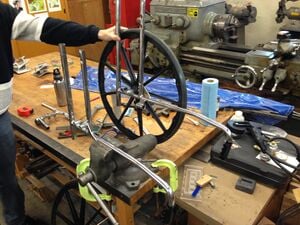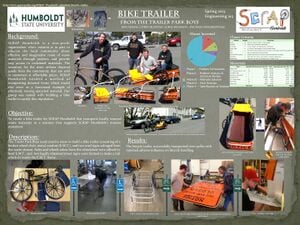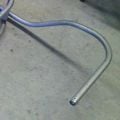
These are the steps that our team The Trailer Park Boys used to construct our bicycle trailer. The components below include a wheel chair, a conduit frame, a road sign tub, a cover, the tongue, and hitch. Instructions are listed below for each component.
Preparing the Wheelchair[edit | edit source]

The wheelchair is an essential item in our design.
- Disassemble wheelchair into individual parts.
- Determine which parts of the wheelchair frame will remain.
- Remove excess material from wheel chair frame.
- Grind and file cuts
- The wheelchair frame will be the starting point from which the rest of the frame will be constructed.
-
Disassembled wheelchair
-
Determining where the cuts are to be made.
-
Making Cuts
-
Shave off rough ends
The Frame[edit | edit source]
The primary material of the frame was galvanized 3/4" conduit. Small sections of standard water pipe where used as well.
- After acquiring conduit, sketch a rough layout for the frame
- Using a conduit bender, bend the conduit appropriately based out your layout. (Note practicing with the conduit bend beforehand is good idea)
- Cut the water pipe into eight four inch sections, these will be used to attach the conduit to the wheelchair frame.
- Braze or weld the water pipe to the wheelchair.
- Cut eight six inch section of conduit and cut parallel half circles in the end, these will separate the two horizontal loops of the frame
- Tack weld the frame together and check for general fit before permanently welding the frame together.
-
Rough sketch.
-
Using a conduit bender to bend conduit.
-
Four pieces of cut water pipe.
-
Braze the larger bends of conduit to the wheelchair
-
Tack weld the smaller cuts to the conduit frame for temporary stability
Street Sign Tub[edit | edit source]
The tub was constructed entirely out of two aluminum street signs.
- Measure dimensions of your frame to sketch dimensions of your tub.
- Use a jig saw to cut the signs to your dimensions.
- Two sections of angle iron clamped to a table can be used as a solid base to make the appropriate bends in the sign.
- Use a large round object if rounded bends need to be made.
- Using extra sections of your sign for backing strips, pop rivet the tub together. (It helps to place the tub in the frame before riveting)
-
Tub dimensions
-
Cut the signs using a jig saw
-
Use a mallet and a piece of wood to hammer the road sign that is set against a sharp, straight edge.
-
The back end of the trailer is rounded. We used a rounded piece of aluminum to hand bend the tub to the correct position.
-
One side bent to the correct position.
-
Tabs cut out aluminum to be used for riveting
-
Pop riveting the tub together
-
The completed road sign
Cover Installation[edit | edit source]
We used Kokotat material supplied by SCRAP Humboldt for it's great defense from the elements
- Take measurements of the tub dimensions for a rough cut. Add additional length to drop down the sides for snaps and for vertical slack (in case payloads are taller than sidewalls).
- Once the cover is rough cut, lay atop the tub to fold, cut and trim as needed for a more finished fitting.
- Acquire snaps and separate female and male parts.
- Drill holes through the tub and pop rivet the male snaps in place.
- Use a proper punch to secure female snaps to Kokotat.
-
Sewing the cover.
-
Male ends fastened to tub.
-
Female ends fastened to the cover.
Tongue Instillation[edit | edit source]
We used conduit to construct the trailers tongue as well for maximum stability.
- The first bend you want to make is a 90 degree bend that lies parallel with the front of the trailer
- Next the pipe will need to be bent so that it has a lift from the ground, rotate and make another bend so that the desired section of the pipe is ten inches off of the ground
- The tongue needs to be attached to the frame. Our solutions was to mold some of the excess road sign into a shell that fit around both the frame and the tongue and bolt road sign shell and tongue together.
-
Here is how our tongue came out. It has two different types of bends so it can be hitched to the bike.
-
The tongue once it is fastened with bolts.
Hitch Construction[edit | edit source]
The primary components of the hitch are an aluminum slug, heim joint, angle iron, and hitch pin.
- The aluminum slug was fitting to the inside of the open end of the tongue.
- The aluminum slug was then drilled and tapped appropriately for the already acquired heim joint.
- Next the slug was fastened to the conduit via machine screws.
- A nut with a lock washer was threaded onto the heim joint prior to threading heim joint into the slug. This allows the heim joint to be fixed in a horizontally position
- The receiving end of the hitch is simply a small section of 1/4" angle iron that has be shaped and drilled to fit the rear axle diameter and the hitch pin.
-
This aluminum slug that is used to connect the heim joint and tongue together.
-
The heim joint before it is threaded into the aluminum slug
-
The heim joint is threaded into the aluminum slug which is fastened to the end of the tongue
-
The complete and assembled hitch assembly.

























